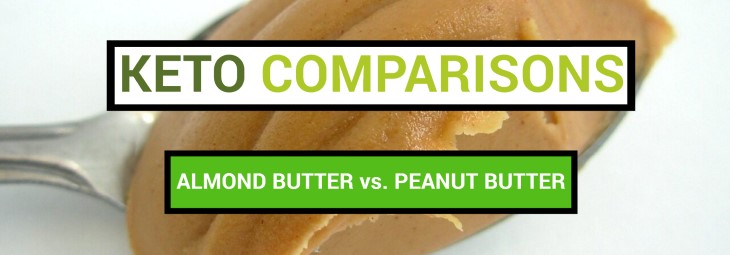
It’s time for breakfast, and you have a warm piece of keto toast in front of you. Now, which spread are you going to use? Almond or peanut butter? While they might have similar nutritional content and qualities, they do have some differences. So, which is better to have while following a low-carb diet?
Read on to learn the nutritional differences between the two, when to use one over the other, and which is ultimately the winner to use when doing a ketogenic diet.
Both nuts are found in the same nutritional family: fats. In the following table, you can find the nutritional content for one tablespoon of each product.
| Nutrients | Almond butter (1 tablespoon) | Peanut butter (1 tablespoon) |
| Energy | 98 kcal | 102 kcal |
| Fat | 8.9 g | 8.2 g |
| Protein | 3.4 g | 3.6 g |
| Net carbs | 1.3 g | 2.8 g |
| Total carbs | 3 g | 3.6 g |
| Fiber | 1.7 g | 0.8 g |
Now that we have compared them side by side, let’s talk about the similarities and differences regarding the nutritional content.
In general, they both have a similar calorie, fat, protein, and total carb content. They differ in the amount of fiber, which gives a different net carb count.
Almond butter has almost twice as much fiber compared to peanut butter. This is important when you are following a keto diet since you will have fewer net carbs. The almond spread has 1.5 g fewer grams of net carbs per tablespoon.
Although this might sound like an insignificant amount, this might be the game-changer in the ketosis state for someone with a very low carb intake (around 25 g).
Regarding the micronutrient content, they both provide similar content for magnesium. However, peanut butter is higher in manganese and potassium. Meanwhile, the almond kind is higher in calcium.
Although the nutritional content is very similar, there are a couple of differences between these two spreads.
The first difference is regarding flavor. Peanuts tend to have a nutty, sweet, and salty taste. On the other hand, almonds have a nuttier but more earthy flavor, which most people find stronger and more intense.
Another difference is cost. Almond butter might be slightly more expensive. It all depends on the type of brand and if it is organic or natural. But in the end, it might cost you a few more bucks.
Finally, the ingredients added to each one might vary. Peanut butter tends to be more processed. There is a bigger chance that processed and refined oils are added, along with sugar and preservatives.
Whichever you are considering buying, make sure to read the ingredient list thoroughly before making a decision.
Since they have a similar nutritional value and almost the same texture, you can substitute almond butter for peanut butter in almost any recipe. They are interchangeable.
In the end, it depends on your flavor preferences and whether you have a very tight carb budget.
Most brands of keto peanut butter might work better for sauces and dressings, depending on the other ingredients. Almond spread might work better with sweeter dishes.
Both are great low-carb options when following a ketogenic diet.
For those on a lower carb intake, keep in mind that almond butter has 1.5 g less net carbs per tablespoon than peanut butter. If you’re eating larger amounts, you may also prefer this option to keep your carbohydrate content lower.
If you have more wiggle room with your carbohydrates, you can choose either of them, depending on your flavor preferences. Remember to choose nut butter without added sugar, read the ingredients list to be sure.
Additionally, it depends on the budget that you have. Since almond butter is slightly more expensive than peanut butter, you may want to stick with the cheaper option.
Remember that variety is key when following any meal plan. You can opt for a peanut one day, while the next one you can have almond. This way, you ensure that you have a diverse range of nutrients.
In the end, both are excellent options to have when doing a ketogenic diet. They are low-carb, high in fat, and contain a decent number of plant-based proteins. For those following vegetarian keto, it is truly a great food to add.
They have similar nutritional content. The only difference is the amount of fiber and the net carbs. Choose the one you prefer based on your daily carb allowance, flavor, and budget.